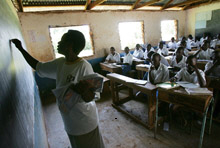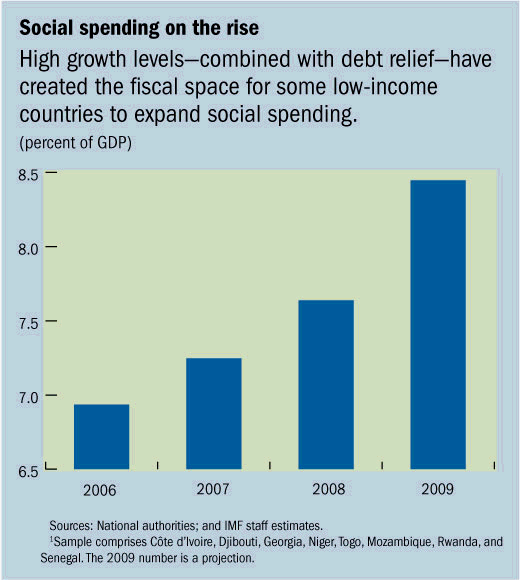
Typical street scene in Santa Ana, El Salvador. (Photo: iStock)
IMF Survey: Despite Crisis, Poor Countries Try to Maintain Social Spending
January 8, 2010
- New IMF lending framework helps countries preserve social spending
- Recent IMF-supported programs place greater emphasis on protecting the poor
- Practical approaches, collaboration with development partners are key to targeting the needy
As part of a series of measures taken to support countries during the global crisis, the IMF is placing new emphasis on preserving social spending in countries that borrow money from it.

School in eastern Kenya: The IMF helps governments mobilize resources for social spending programs that they consider critical (AFP Photo: Roberto Schmidt)
Low-Income Countries
For low-income countries in particular, preserving social spending is vital, as many people in these countries were already coping with the effects of higher food and fuel prices when the global economic crisis struck.
But maintaining social spending—usually defined in low-income countries as spending on health and education—poses a profound challenge in times of crisis. Government are seeing their revenues decline, yet as the ranks of the unemployed grow, allocating money for social spending becomes all the more critical.
“In low-income countries, people have very few options,” says Yongzheng Yang, Deputy Chief of the IMF’s Low-Income Strategy Unit. “There’s no well-established safety net, so when a crisis hits, they risk losing their ability to survive.”
Accommodating higher social spending
For some low-income countries, maintaining social sector spending despite the fall in revenue is possible because they had built up some buffers during the good times of strong growth in recent years. In Africa, for example, low-income countries grew 6½ percent on average between 2004 and 2007. Stronger economic fundamentals as a result of past economic stabilization efforts have enabled some countries to borrow domestically during the crisis to finance part of the increases in government spending. Increased donor aid has also helped, though it has fallen short of commitments.
Case of the Kyrgyz Republic
The Kyrgyz Republic was one of the first countries to take advantage of the IMF’s revamped Exogenous Shocks Facility (ESF) The ESF program, which started in December 2008, is to provide the Kyrgyz Republic with financing of about $100 million over an 18-month period. It was aimed at addressing the consequences of higher world food and fuel prices and a regional slowdown—particularly in Russia and Kazakhstan, the country’s main sources of remittances and trade—caused by the global financial crisis.
The initial ESF program design was more accommodating than the country’s preceding PRGF-supported program. At the time of the ESF’s first review in May 2009, program targets were further relaxed in response to a worsening economic outlook. Despite significantly lower expected revenue, expenditures were slated to increase compared to the initial program.
A salient feature of the Kyrgyz Republic’s program design is the increase in social spending, which plays a vital role in this country whose poverty rate is estimated at 35 percent. Budget allocations to the Unified Monthly benefit—a social assistance program that targets poor households with children—are programmed to increase over the period 2009–11.
Strong growth, successful fiscal consolidation, and improved revenue administration in the recent past have enabled the government to beef up aid to the country’s vulnerable. Social spending is also made possible by significant concessional donor support (equivalent to 9½ percent of GDP) from the Russian Federation, along with debt relief.
“Some countries have followed good macroeconomic policies over the past few years. That, combined with debt relief, has created the fiscal space for many of them to expand social spending,” said Sanjeev Gupta, Deputy Director of the IMF’s Fiscal Affairs Department.
Increased flexibility in IMF programs also enables many countries to maintain, or even increase, social spending. Of the 19 low-income country programs initiated in 2008–09, 16 have budgeted higher social spending. Under a new lending framework, which is expected to be effective soon, many IMF loan programs will place even greater emphasis on safeguarding social spending, including by setting explicit program targets for it where possible. These indicative targets vary from country to country and are not rigid conditions.
“IMF programs aim for macroeconomic frameworks that are supportive of poverty reduction and growth,” says Yang. “To achieve the goal of poverty reduction, you need a certain amount of social spending, which can be monitored through explicit targets.” Some low-income countries, however, are simply not in a position to step up their social spending, Yang notes.
With this new practice, the IMF reinforces the linkage between the programs it supports and the goal of poverty reduction and growth, and acknowledges the importance of taking exceptional measures to protect the poor during the current crisis.
As the crisis period comes to an end, however, countries will have to reprioritize government spending in order to maintain this strengthened linkage and preserve their debt sustainability.
Targeting spending to those who need it
But merely preserving (or increasing) social spending is not enough—countries have long sought ways of better targeting this spending to ensure that it benefits the most vulnerable people. Such targeting is not always easy, Gupta notes. And sometimes governments’ attempts to protect the poor have had unintended consequences.
During the food and fuel crisis of 2007–08, for example, some countries responded by introducing generalized subsidies on petroleum products so as to avoid passing on the higher world price to domestic consumers. But generalized fuel subsidies are poorly targeted, according to a recent IMF study.
The study found that most of the benefit from fuel subsidies goes to households with higher incomes. The benefits of gasoline subsidies are the most regressively distributed, with over 80 percent of the total benefits accruing to the richest 40 percent of households. For subsidies of liquefied petroleum gas, over 70 percent of benefits accrue to these income groups. The indirect impact of fuel subsidies, mainly diesel, is channeled through lower prices for other goods and services. The distribution of these subsidies therefore tends to be as unequal as the distribution of total consumption, with the top two income quintiles benefiting from over 65 percent of the subsidies.
“So you’re giving a subsidy on the grounds that you’re protecting the poor, but the bulk of the benefit actually accrues to the rich,” Gupta explains. A better way to target government assistance for poorer households, the IMF says, would be to increase spending on well-targeted social programs rather than budgeting for fuel subsidies.
Indirect targeting
Targeting the vulnerable in low-income countries presents a special challenge because most countries in this category have large informal sectors. “In many places, targeting is difficult because we have only scant information on what people’s real income is—unlike in the advanced countries, where most people file income tax returns,” says Gupta.
IMF ramps up support for poor
The IMF has significantly scaled up its support to low-income countries as part of its response to the global economic crisis. Measures adopted by the IMF in the past year include:
• Scaled-up concessional financial assistance to low-income countries to boost the Fund’s concessional lending capacity by up to $17 billion through 2014, including up to $8 billion in the first two years
• Interest relief, with zero payments on outstanding IMF concessional loans through end-2011 to help low-income countries cope with the crisis
• Permanently higher concessionality of Fund financial support
• Doubling of average loan access limits for low-income countries
• A new set of financial instruments tailored to the diverse needs of low-income countries and better suited to meet the crisis challenges
• A new general SDR allocation of $250 billion, of which more than $18 billion has helped bolster the foreign exchange reserves of low-income countries
• Streamlined conditionality in IMF-supported programs, with loans no longer including conditions on specific, timebound measures.
Because of the dearth of data in poor countries, indirect targeting is the most practical solution, Gupta notes. Governments can provide subsidies on the basis of socioeconomic or demographic characteristics, targeting such groups as the elderly, children, or the unemployed that are likely to be poor. Geographic targeting—limiting the coverage of a subsidy to those living in a particularly impoverished region—can also be used. Another successful form of targeting links cash benefits to a schooling requirement.
“Using some filter criteria, you try to target people who are in need,” explains Yang. “It’s an imprecise tool—you’re probably benefiting some who are not in need, but at least you capture a large proportion of those who are.”
Successful targeting programs are being used in several low-income countries with IMF-supported programs. In Guatemala, a new government program of conditional cash transfers was put in place in 2008. The program, Mi familia progresa, aims at ensuring that poor children attend school and visit health centers regularly. The program covered 281,000 families in 2008, but has been expanded in 2009 with the goal of reaching 500,000 families. Its budget is expected to grow to $150 million. Similar conditional cash transfer programs—modeled after one pioneered in Mexico in the late 1990s—are in place throughout Latin America.
Governments are employing various other strategies to improve the targeting of social spending. The direct distribution of food, seeds, and fertilizers has been used recently in such countries as Burundi and Mali, and the provision of free school uniforms and textbooks has been initiated in Ghana. In Pakistan, where strengthening the social safety net is a key priority of the IMF-supported program, the government is providing direct cash transfers to the poor.
Donor financing has been crucial to the success of many of these social programs. And although the design of cash transfer programs and other social safety net programs is not the domain of the IMF but rather the World Bank and other development banks, the IMF has played a large role in helping countries mobilize and reallocate resources to shield the poor.
But resources are not the only constraint, Yang stresses. “The capacity for delivering social programs is often weak, and each country faces its own unique challenges. The key is for countries to decide in a transparent manner what they consider to be socially critical and to explore different approaches to targeting with expert help from development partners.”
Even as low-income countries cope with the current crisis, it may not be too soon to plan for the next one. “We need to prepare for the next big shock, so we don’t find ourselves with very few instruments for protecting the poor,” Yang says. “We are working with the World Bank, regional development banks, and donors who have expertise in figuring out what works best in each country.”



